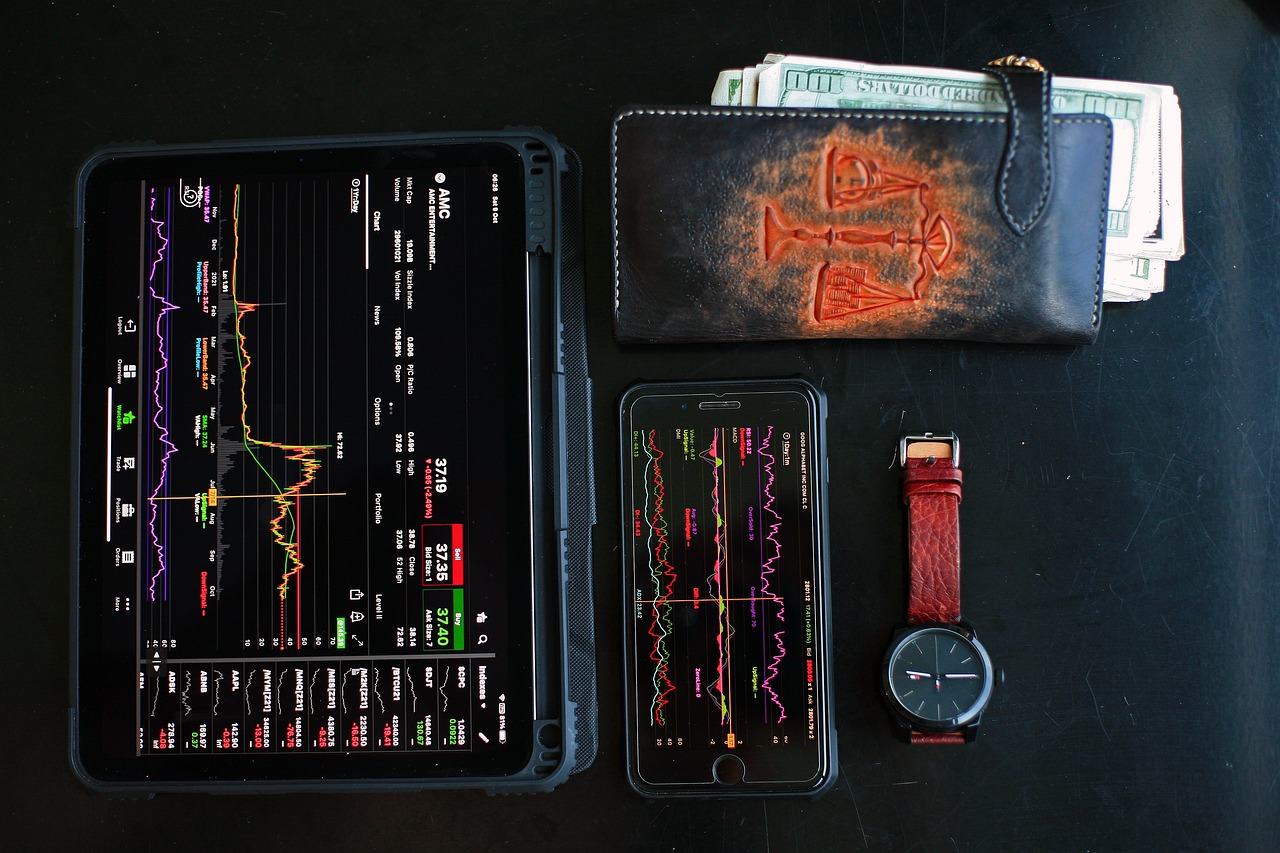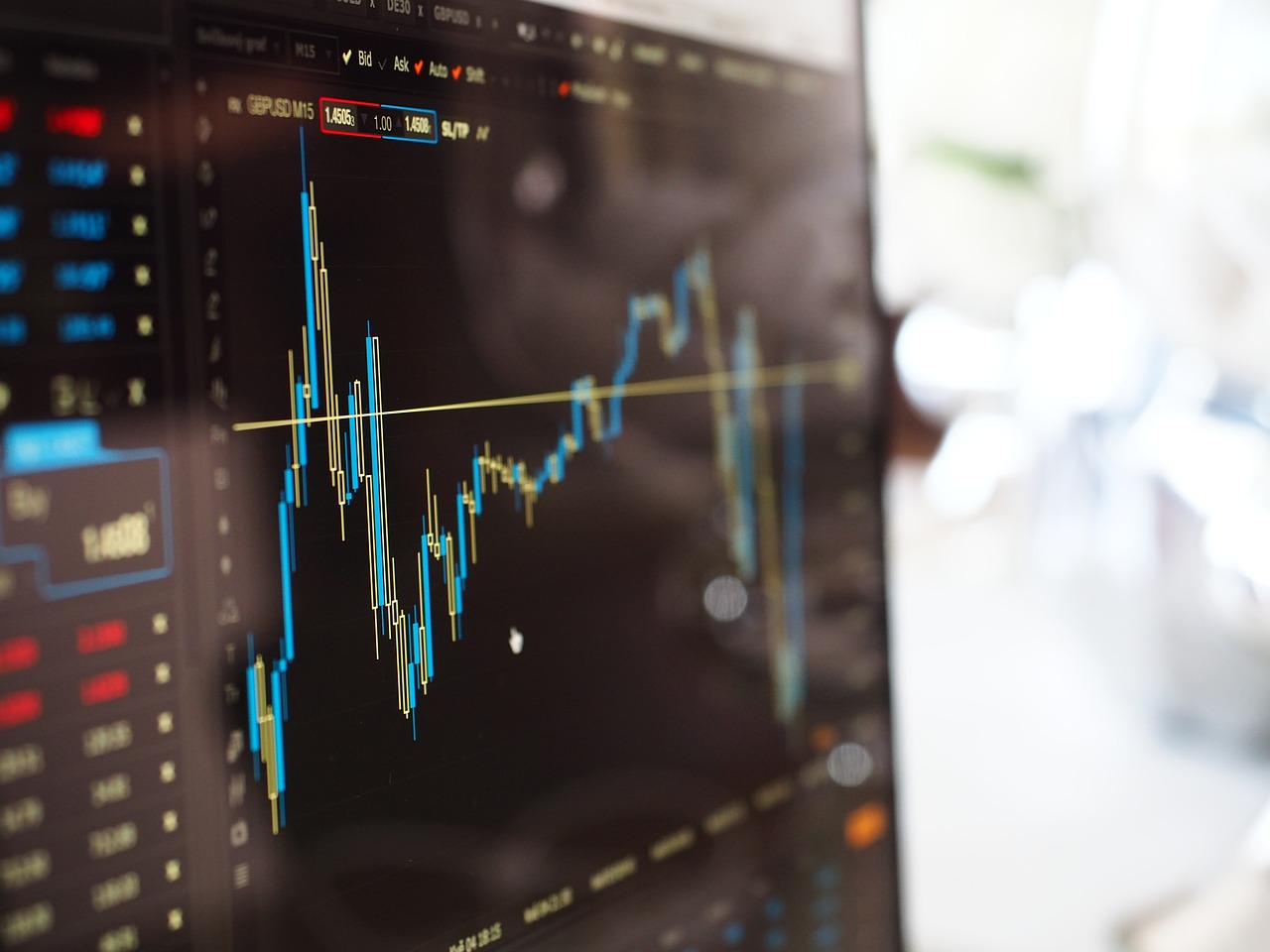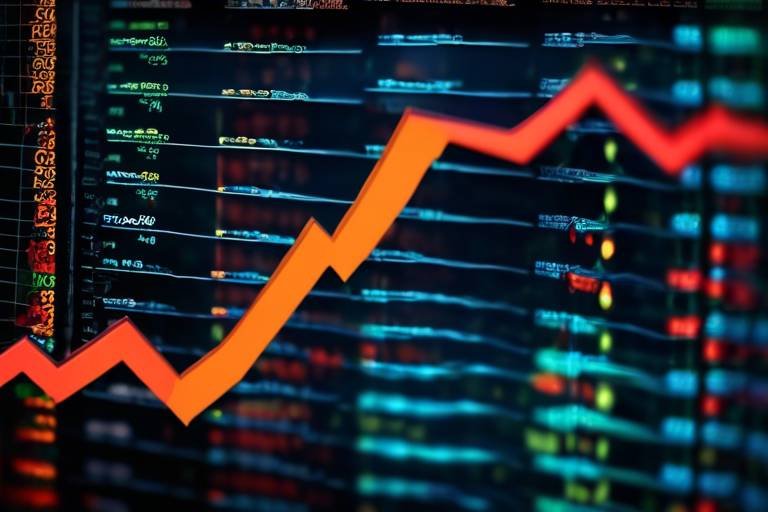Understanding the Dynamics of Market Depth in Crypto Trading
In the fast-paced world of cryptocurrency trading, understanding market depth is akin to having a compass in a dense forest. It guides traders through the chaotic landscape of buy and sell orders, helping them make informed decisions. Market depth is not just a technical term; it’s a vital concept that can significantly influence trading strategies and outcomes. But what exactly is market depth, and why should traders care? This article will delve into the intricacies of market depth, exploring its components, implications, and how traders can leverage this knowledge for better trading decisions.
Market depth refers to the market's capacity to absorb large orders without causing substantial price fluctuations. Think of it as the foundation of a building; if the foundation is strong, the structure can withstand various pressures. In trading, a deep market can handle significant buy or sell orders without a drastic impact on the cryptocurrency's price. This concept is crucial for traders, especially those looking to execute large trades, as it directly affects their ability to enter and exit positions smoothly.
At the heart of market depth lies the order book, a real-time list of all buy and sell orders for a particular cryptocurrency. The order book is like a window into the market’s soul, revealing the underlying supply and demand dynamics. By analyzing the components of the order book, traders can gauge market sentiment, liquidity, and potential price movements. Let's break down the key components:
The order book is divided into two primary sections: buy orders and sell orders. Each section provides valuable insights into market activity. Understanding these orders can help traders identify potential support and resistance levels, making it easier to formulate effective trading strategies.
Buy orders represent the demand side of the market. They indicate how much traders are willing to pay for a cryptocurrency at various price levels. By analyzing buy orders, traders can identify potential support levels—prices at which buying interest is strong enough to prevent further declines. For instance, if a large number of buy orders accumulate at a certain price, it signals that traders believe the asset is undervalued, prompting them to buy.
Conversely, sell orders reflect the supply side, showcasing how much sellers are willing to accept for their assets. Understanding sell orders can reveal potential resistance levels, where selling pressure might prevent the price from rising further. For example, if a significant number of sell orders are clustered at a particular price, it indicates that many traders are looking to cash out, which could lead to price stagnation or decline.
Liquidity is a critical aspect of market depth. It determines how quickly an asset can be bought or sold without causing significant price changes. In a highly liquid market, large orders can be executed with minimal slippage, meaning the price won’t change drastically between the order being placed and the execution. Higher liquidity often leads to better trading conditions, allowing traders to enter and exit positions more efficiently.
Understanding market depth is not just an academic exercise; it has real-world implications for trading strategies. Traders can use insights gained from market depth to optimize their entry and exit points, ultimately enhancing their profitability. For instance, a trader might spot a cluster of buy orders that suggests a strong support level and decide to enter a long position. Conversely, if they observe a wall of sell orders at a certain price, they might choose to delay their purchase or set a sell order at that level.
For those who engage in scalping, which involves making quick trades to capitalize on small price movements, understanding market depth is essential. By keeping an eye on the order book, scalpers can identify ideal moments to enter and exit trades efficiently, maximizing their chances of profit. They can quickly spot when there’s a surge in buy or sell orders, allowing them to act fast and take advantage of fleeting opportunities.
For long-term investors, market depth provides insights into the overall health and stability of the market. By analyzing market depth over time, investors can make informed decisions about when to enter or exit positions. A consistently deep market may indicate a healthy ecosystem, while sudden changes in depth could signal underlying issues that warrant caution.
While market depth offers valuable insights, it also presents challenges that traders must navigate. The cryptocurrency market is notorious for its volatility, and market depth can change rapidly, making it crucial for traders to remain vigilant. Additionally, the potential for market manipulation poses a significant risk; traders may encounter misleading signals that could lead to poor decision-making.
Market manipulation can distort the order book, leading to misinterpretations of market depth. For instance, a trader might place a large sell order to create the illusion of selling pressure, tricking others into thinking the price will drop. Awareness of these risks is vital for traders to avoid falling into traps set by manipulative practices.
Given the high volatility of cryptocurrency markets, market depth can fluctuate dramatically within short time frames. Traders must adapt their strategies accordingly, staying alert to changes in depth that could impact their positions. This dynamic nature of market depth means that successful traders are those who can quickly adjust to new information and market conditions.
- What is market depth in crypto trading? Market depth refers to the market's ability to sustain large orders without significantly impacting the price.
- Why is liquidity important? Liquidity determines how quickly an asset can be bought or sold without affecting its price, impacting trading conditions.
- How can I use market depth in my trading strategy? By analyzing buy and sell orders, traders can identify support and resistance levels, optimizing their entry and exit points.

What is Market Depth?
Market depth is a fundamental concept in the world of cryptocurrency trading that refers to the market's ability to absorb large buy or sell orders without causing significant price fluctuations. Imagine a bustling marketplace where buyers and sellers are constantly engaging in transactions. Market depth essentially measures how well this marketplace can handle large trades without tipping the scales too dramatically. Understanding market depth is crucial for traders because it provides insights into the liquidity and overall health of the market.
At its core, market depth is represented through an order book, which lists all active buy and sell orders at different price levels. This order book is like a live feed that displays the supply and demand for a particular cryptocurrency in real-time. Traders can analyze this data to gauge market sentiment, identify potential support and resistance levels, and make informed decisions about their trades. Essentially, the order book acts as a window into the market's psyche, revealing how traders feel about the asset at any given moment.
To break it down further, market depth can be visualized through a graphical representation, often referred to as a depth chart. This chart plots buy orders on one side and sell orders on the other, illustrating the volume of orders at various price points. The steeper the curve, the more significant the volume of orders at that price level, indicating stronger support or resistance. This visual tool is invaluable for traders looking to understand where the market might be heading, as it highlights areas of interest where buying or selling pressure is concentrated.
In summary, market depth is not just a technical term; it’s a vital aspect of trading that can significantly impact your strategy. By analyzing market depth, traders can better navigate the complexities of the cryptocurrency landscape, making more informed decisions that can lead to greater profitability.

Components of Market Depth
Market depth is a fascinating concept that encapsulates the intricate workings of cryptocurrency trading. At its core, it consists of two primary components: the order book and the associated buy and sell orders. Understanding these components is crucial for traders who wish to navigate the often turbulent waters of the crypto market effectively. Think of the order book as a window into the market's soul; it reveals the underlying supply and demand dynamics that drive price movements.
The order book is essentially a live record of all active buy and sell orders for a specific cryptocurrency. It provides a real-time snapshot of market sentiment, allowing traders to gauge whether there is more buying or selling pressure at any given moment. This information can be invaluable, especially when making split-second trading decisions. By analyzing the order book, traders can identify potential support and resistance levels, which are critical for executing well-timed trades.
To delve deeper into the order book, let’s break it down further. The order book is typically divided into two main sections: buy orders and sell orders. Each section contains various price levels and the corresponding quantities of each order. This structure allows traders to visualize the market's depth. For instance, if you see a large number of buy orders clustered around a specific price point, it could indicate a strong support level, suggesting that prices may not drop significantly below that level.
Buy orders are the lifeblood of market demand. They represent how much traders are willing to pay for a particular cryptocurrency at various price levels. By analyzing these orders, traders can identify potential support levels where buying interest is robust. For example, if a trader notices a significant accumulation of buy orders at a certain price, they might infer that the price is likely to bounce back if it approaches that level. It’s like finding a safety net in a high-wire act; it gives traders confidence that they can make informed decisions without taking unnecessary risks.
On the flip side, sell orders showcase the supply side of the equation. They indicate how much sellers are willing to accept for their cryptocurrency. Understanding these orders is equally crucial, as they can reveal potential resistance levels. If a trader spots a large volume of sell orders at a specific price, it might suggest that the price could struggle to rise above that level. In this way, sell orders act like a ceiling, preventing prices from soaring too high too quickly.
Liquidity is another critical aspect of market depth. It refers to how quickly an asset can be bought or sold without causing a significant impact on its price. High liquidity often translates to better trading conditions, as it allows traders to enter and exit positions with ease. In a highly liquid market, large buy or sell orders can be executed without causing drastic price fluctuations, creating a more stable trading environment. Conversely, in a market with low liquidity, even a modest order can lead to significant price swings, making it a risky playground for traders.
To summarize, the components of market depth—comprised of the order book, buy orders, sell orders, and liquidity—are essential for traders looking to enhance their trading strategies. By understanding these elements, traders can make more informed decisions, identify trends, and optimize their entry and exit points. In the fast-paced world of cryptocurrency trading, knowledge is power, and mastering market depth can be the key to unlocking greater profitability.
- What is market depth? Market depth refers to the market's ability to sustain large orders without significantly affecting the price of the cryptocurrency.
- How does the order book work? The order book displays all active buy and sell orders, providing insights into market supply and demand.
- Why is liquidity important? Liquidity determines how quickly an asset can be traded without impacting its price, making high liquidity preferable for traders.
- What are buy and sell orders? Buy orders indicate the demand side of the market, while sell orders reflect the supply side, both of which are crucial for understanding market dynamics.

The Order Book Explained
The order book is like the heartbeat of the cryptocurrency market. It acts as a real-time ledger that displays all active buy and sell orders for a particular cryptocurrency. Imagine it as a bustling marketplace where buyers and sellers are constantly negotiating prices. Each entry in the order book represents a trader's willingness to buy or sell at a specific price, and together, these entries create a comprehensive view of market supply and demand.
When you look at the order book, you'll notice two main sections: the buy orders and the sell orders. The buy orders indicate how much traders are willing to pay for a cryptocurrency, while the sell orders show how much sellers are willing to accept. This dynamic interplay between buyers and sellers is crucial for understanding market sentiment. For instance, if there are significantly more buy orders than sell orders at a particular price level, it could indicate strong demand, potentially pushing the price up. Conversely, a larger number of sell orders may suggest resistance, signaling that the price could struggle to rise above that level.
To illustrate this concept, consider the following simplified example of an order book:
| Price | Buy Orders | Sell Orders |
|---|---|---|
| $10,000 | 5 BTC | 2 BTC |
| $10,100 | 3 BTC | 4 BTC |
| $10,200 | 10 BTC | 1 BTC |
In this table, you can see various price levels along with the corresponding amounts of buy and sell orders. The price at which the most buy orders are concentrated could be seen as a support level, while the price with the most sell orders might represent a resistance level. By analyzing these orders, traders can make more informed decisions about when to enter or exit trades.
Moreover, the order book is constantly changing, reflecting the dynamic nature of the market. This means that traders need to stay alert and be ready to act quickly. In a fast-moving market, a trader might see a sudden influx of buy orders that could signal a potential price surge, or a spike in sell orders that might indicate a downturn. Understanding how to read and interpret the order book can give traders a significant edge in their trading strategies.
In conclusion, the order book is an essential tool for any cryptocurrency trader. It provides a wealth of information about market sentiment, potential price movements, and trading opportunities. By mastering the art of reading the order book, traders can better navigate the often turbulent waters of cryptocurrency trading.
- What is the purpose of the order book? The order book displays all active buy and sell orders, providing insights into market supply and demand.
- How can I use the order book to improve my trading? By analyzing the order book, traders can identify support and resistance levels, helping them make informed decisions about entry and exit points.
- Is the order book the same for all exchanges? No, the order book can vary between exchanges based on the number of participants and the volume of trades.
- Can the order book be manipulated? Yes, market manipulation can distort the order book, leading to misleading interpretations. Traders should be cautious and aware of these risks.

Buy Orders
Buy orders are a fundamental aspect of the cryptocurrency trading landscape, acting as the heartbeat of market demand. When traders place buy orders, they indicate how much they are willing to pay for a specific cryptocurrency at various price levels. Understanding buy orders is essential for anyone looking to navigate the often turbulent waters of crypto trading. Think of buy orders as a fishing net; the more precise and strategic your placement, the better your chances of landing a big catch!
Analyzing buy orders can reveal crucial information about potential support levels in the market. For instance, if you notice a significant cluster of buy orders at a specific price point, it suggests that many traders believe that price represents a good value. This can create a psychological barrier, making it less likely for the price to drop below that level. Conversely, if buy orders are sparse, it might signal a lack of confidence among traders, indicating that the price could continue to fall.
Let’s break down the key elements of buy orders:
- Price Levels: Buy orders are placed at different price levels, and observing these levels can help traders identify where demand is strongest.
- Order Size: The size of a buy order can indicate the strength of demand. Larger orders may suggest that institutional investors are stepping in, while smaller orders could be indicative of retail trading.
- Time Sensitivity: Timing is everything in trading. Buy orders can change rapidly, so staying updated with the order book is crucial.
Moreover, buy orders can also provide insights into market sentiment. If the market is bullish, you will typically see a higher volume of buy orders, reflecting traders' optimism about future price increases. On the other hand, a sudden drop in buy orders can signal a shift in sentiment, prompting traders to reassess their positions.
To illustrate this concept better, consider the following table that outlines a hypothetical order book for a cryptocurrency:
| Price Level (USD) | Buy Orders (Quantity) |
|---|---|
| 50,000 | 10 BTC |
| 49,500 | 5 BTC |
| 49,000 | 20 BTC |
| 48,500 | 15 BTC |
This table shows various price levels and the corresponding buy orders. Notice how the largest buy order is at $49,000, indicating strong demand at that price point. Traders can use this information to make informed decisions, such as setting their own buy orders just above these levels to increase the chances of execution.
In summary, understanding buy orders is not just about knowing how much you want to pay for a cryptocurrency; it’s about reading the market's pulse. By analyzing buy orders, traders can gain a deeper understanding of market dynamics, identify potential support levels, and make strategic trading decisions that align with market sentiment. So, the next time you dive into the crypto trading arena, remember to keep an eye on those buy orders—they might just hold the key to your success!

Sell Orders
Sell orders are a crucial component of the cryptocurrency trading ecosystem, representing the supply side of the market. When traders place sell orders, they indicate how much they are willing to accept for their assets, which in turn helps define the market's price structure. Understanding sell orders is essential for any trader looking to navigate the often tumultuous waters of cryptocurrency trading. Just like a bustling marketplace, where vendors display their goods at various prices, the sell orders in the order book reveal the sellers' pricing strategies and their willingness to part with their cryptocurrencies.
Analyzing sell orders can provide significant insights into potential resistance levels in the market. For instance, if a large number of sell orders are clustered around a specific price point, this could indicate a strong resistance level, making it challenging for prices to rise above that threshold. Conversely, if the sell orders are sparse, it may signal a more favorable environment for price increases, as there are fewer sellers willing to offload their assets. This dynamic is akin to a game of tug-of-war, where the strength of the sellers can determine the market's direction.
Moreover, sell orders can be categorized into different types, each serving a unique purpose:
- Market Orders: These are sell orders executed at the best available price in the market. They are often used by traders looking to quickly liquidate their positions.
- Limit Orders: These orders are set at a specific price level. Sellers use limit orders to ensure they receive a certain price for their assets, which can help avoid selling during a price dip.
- Stop-Loss Orders: These are designed to limit losses by automatically selling an asset when it reaches a predetermined price, protecting traders from significant downturns.
Understanding the interplay of these different types of sell orders can empower traders to make more informed decisions. For example, if a trader notices a surge in limit sell orders at a specific price level, they might choose to adjust their strategy accordingly, either by setting their own limit orders just below that level to capitalize on the potential resistance or by opting to wait for a more favorable entry point.
In summary, sell orders are not just numbers on a screen; they tell a story about market sentiment and trader behavior. By paying close attention to these orders, traders can gain valuable insights into market dynamics, helping them to anticipate price movements and make strategic trading decisions. Just like a seasoned detective piecing together clues, savvy traders can use sell orders to uncover the hidden patterns that drive the cryptocurrency market.
What are sell orders in cryptocurrency trading?
Sell orders are instructions placed by traders to sell their cryptocurrencies at specified prices, reflecting the supply side of the market.
How do sell orders affect market prices?
Sell orders can create resistance levels in the market. A high concentration of sell orders at a particular price may prevent prices from rising above that level.
What types of sell orders can I place?
You can place market orders, limit orders, and stop-loss orders, each serving different purposes for managing your trades.
Why is it important to analyze sell orders?
Analyzing sell orders helps traders understand market sentiment, identify resistance levels, and make informed trading decisions.

Liquidity and Its Importance
When diving into the world of cryptocurrency trading, one term that often pops up is liquidity. But what does it really mean? Simply put, liquidity refers to how easily an asset can be bought or sold in the market without causing a significant change in its price. Imagine trying to sell a rare painting; if there are only a handful of buyers, you might have to lower the price to attract interest. On the other hand, if you’re selling a popular print, you’ll likely find a buyer quickly and at a price you’re comfortable with. This analogy perfectly illustrates the essence of liquidity in trading.
In the crypto space, liquidity is crucial because it directly affects your trading experience. Higher liquidity means that you can enter and exit positions swiftly without worrying about slippage—the difference between the expected price of a trade and the actual price. For instance, if you want to sell a large amount of Bitcoin, high liquidity ensures that you can do so at the market price without causing the price to plummet. Conversely, in a market with low liquidity, even a modest sell order can lead to a significant price drop, leaving you with less profit than anticipated.
Moreover, liquidity is not just about the ability to buy or sell; it also reflects the overall health of a market. A highly liquid market typically indicates strong demand and supply, which can be a sign of stability. Traders often look at liquidity as a barometer for market sentiment. If you notice that liquidity is dwindling, it might be a red flag, suggesting that traders are losing interest or that the market is becoming more volatile.
To further illustrate the importance of liquidity, let’s consider a table comparing two hypothetical cryptocurrencies:
| Cryptocurrency | Liquidity Level | Market Impact |
|---|---|---|
| Crypto A | High | Minimal price impact on large orders |
| Crypto B | Low | Significant price drop on large orders |
As seen in the table, Crypto A has high liquidity, allowing traders to execute large orders without drastically affecting the price. In contrast, Crypto B’s low liquidity means that even a small order could lead to substantial price fluctuations, making it a riskier asset to trade.
Ultimately, understanding liquidity is vital for any trader looking to navigate the crypto market effectively. It not only influences trading strategies but also impacts overall market dynamics. So, whether you’re a seasoned trader or just starting, keeping an eye on liquidity can help you make more informed decisions and enhance your trading experience.
- What is liquidity in cryptocurrency? Liquidity refers to how easily a cryptocurrency can be bought or sold without affecting its price.
- Why is liquidity important for traders? Higher liquidity allows traders to enter and exit positions quickly and with less price impact.
- How can I assess the liquidity of a cryptocurrency? Look at the order book, trading volume, and price stability to gauge liquidity.
- What happens in low liquidity markets? In low liquidity markets, even small trades can lead to significant price changes, increasing trading risk.

Impact of Market Depth on Trading Strategies
The impact of market depth on trading strategies cannot be overstated. It serves as a critical tool that traders can leverage to make informed decisions. When you think about it, market depth is like a window into the heart of the market, providing insights into supply and demand dynamics. By analyzing this data, traders can optimize their entry and exit points, ultimately enhancing their profitability. But how exactly does one do this? Let's dive deeper.
For instance, consider a trader looking to enter a position. By examining the order book, they can see where the buy orders are concentrated. This information can help identify potential support levels. If there are a significant number of buy orders at a particular price, it may indicate that the price is unlikely to drop below that level, presenting a good entry point for the trader. On the flip side, understanding where the sell orders are concentrated allows traders to spot potential resistance levels. If a trader notices a large number of sell orders at a certain price, they might decide to hold off on buying until the price dips below that resistance.
Moreover, market depth can significantly influence different trading styles. For example, scalpers, who thrive on making quick trades, can use market depth to time their entries and exits more effectively. By observing the fluctuations in the order book, they can identify moments when liquidity is high, allowing them to execute trades swiftly without substantial slippage. Conversely, long-term investors can benefit from understanding market depth as well. By analyzing the overall health of the market, they can make more informed decisions about when to buy or sell their assets over time.
However, it’s essential to recognize that while market depth can enhance trading strategies, it is not without its challenges. The cryptocurrency market is notoriously volatile, and the depth can change rapidly. Traders must remain vigilant and ready to adapt their strategies accordingly. Additionally, market manipulation is a risk that traders must navigate. Certain players might place large orders to create a false sense of market sentiment, leading others to make poor decisions based on misleading data. Thus, being aware of these risks is crucial for anyone looking to leverage market depth effectively.
In summary, understanding market depth can significantly enhance trading strategies. By recognizing where buy and sell orders are concentrated, traders can make more informed decisions, whether they are scalping for quick profits or investing for the long haul. It's all about using the information available in the order book to your advantage, while also being mindful of the inherent risks involved in the dynamic world of cryptocurrency trading.
- What is market depth? - Market depth refers to the market's ability to sustain large orders without impacting the price of a cryptocurrency.
- How does market depth affect trading strategies? - Analyzing market depth helps traders identify support and resistance levels, optimize entry and exit points, and adapt their strategies to market conditions.
- What are the risks associated with market depth analysis? - Risks include market manipulation and rapid changes in market conditions that can mislead traders.
- Can market depth help with long-term investing? - Yes, it provides insights into overall market health, helping investors make better decisions over time.

Scalping Strategies
Scalping is a trading strategy that focuses on making numerous small profits on minor price changes throughout the day. Imagine being a sprinter in a race, where every second counts; this is the essence of scalping in the fast-paced world of cryptocurrency trading. Traders who employ this strategy, known as scalpers, aim to capitalize on tiny fluctuations in price by executing a high volume of trades. But what makes scalping so appealing? The thrill of quick gains, the ability to leverage small market movements, and the potential for significant profits when executed correctly.
To effectively implement scalping strategies, traders need to have a solid grasp of market depth. This understanding allows them to identify moments when there’s a high probability of price movement. For instance, if a trader notices a significant number of buy orders stacked up at a certain price level, they might anticipate a price increase, making it an opportune moment to buy. Conversely, if there’s a large volume of sell orders, it could signal a potential price drop. This information is crucial for scalpers, who thrive on making split-second decisions.
One effective scalping strategy involves monitoring the order book closely. By observing the buy and sell walls, traders can spot levels of support and resistance. A buy wall occurs when there are many buy orders at a specific price, while a sell wall indicates a high number of sell orders. Understanding these walls can help scalpers predict price movements, allowing them to enter trades just before significant shifts occur.
Moreover, scalpers often rely on technical indicators to complement their analysis. Indicators such as the Relative Strength Index (RSI) and Moving Averages can provide valuable insights. For example, if the RSI shows that a cryptocurrency is oversold, it might be a good time to buy, anticipating a price rebound. This combination of market depth analysis and technical indicators creates a robust strategy that maximizes the chances of success in scalping.
However, it’s essential to note that scalping is not without its risks. The fast-paced nature of this strategy means that traders must be prepared to react quickly to market changes. Additionally, transaction fees can eat into profits if not managed properly. Therefore, scalpers should always be aware of their brokerage fees and choose platforms that offer low transaction costs to maintain profitability.
In summary, scalping strategies in cryptocurrency trading require a keen understanding of market depth, quick decision-making skills, and the ability to analyze technical indicators. While it can be a thrilling way to trade, it also demands discipline and a solid risk management strategy. So, are you ready to put your sprinting shoes on and dive into the world of scalping?
- What is scalping in crypto trading? Scalping is a trading strategy that involves making a large number of trades to profit from small price changes.
- How do I analyze market depth for scalping? Traders analyze the order book, looking for buy and sell walls, and use technical indicators to inform their decisions.
- What are the risks of scalping? The main risks include rapid market changes and high transaction fees that can diminish profits.
- Can I use scalping as a long-term strategy? Scalping is typically a short-term strategy, but some traders may incorporate it into a broader trading plan.

Long-Term Investing Considerations
This article explores market depth in cryptocurrency trading, examining its significance, components, and implications for traders. We will also discuss strategies to leverage market depth for better trading decisions.
Market depth refers to the market's ability to sustain relatively large market orders without impacting the price of the cryptocurrency. Understanding this concept is crucial for effective trading.
Market depth is comprised of the order book, which includes buy and sell orders at various price levels. Analyzing these components helps traders gauge market sentiment and liquidity.
The order book displays all active buy and sell orders for a particular cryptocurrency. It provides insights into market supply and demand, essential for making informed trading decisions.
Buy orders represent the demand side of the market, showcasing how much traders are willing to pay. Analyzing these orders helps identify potential support levels.
Sell orders reflect the supply side, indicating how much sellers are willing to accept. Understanding these orders can highlight resistance levels and price trends.
Liquidity is a key factor in market depth, determining how quickly an asset can be bought or sold without significant price changes. Higher liquidity often leads to better trading conditions.
Market depth plays a critical role in shaping trading strategies. Traders can use this information to optimize entry and exit points, enhancing overall profitability.
Scalping involves making quick trades to capitalize on small price movements. Understanding market depth can help scalpers identify ideal moments to enter and exit trades efficiently.
When it comes to long-term investing in cryptocurrencies, market depth serves as a vital compass, guiding investors through the often turbulent waters of the crypto market. Unlike day traders who thrive on quick, fleeting price movements, long-term investors focus on the overall health and stability of their chosen assets. By analyzing market depth, investors can gain insights into the liquidity and volatility of a cryptocurrency, which are crucial factors in determining whether to hold or sell an asset over time.
For instance, if the order book reveals a strong accumulation of buy orders at certain price levels, it might indicate robust support for the cryptocurrency, suggesting that it could be a good time to enter a position. Conversely, a lack of buy orders or an overwhelming number of sell orders can signal potential resistance, prompting investors to reconsider their strategies. In this way, understanding market depth not only aids in timing but also enhances the overall investment strategy.
Moreover, the implications of market depth extend beyond immediate price movements. As cryptocurrencies continue to evolve, the ability to analyze market depth can help investors identify long-term trends and shifts in market sentiment. For example, a consistent increase in buy orders over time could indicate growing confidence in a specific cryptocurrency, while a spike in sell orders might suggest an impending downturn. By staying informed through market depth analysis, investors can better position themselves to capitalize on emerging opportunities and mitigate risks.
While market depth offers valuable insights, it also presents challenges. Traders must navigate issues like market manipulation and rapidly changing conditions that can affect depth analysis.
Market manipulation can distort the order book, leading to misleading interpretations of market depth. Awareness of these risks is vital for traders to avoid poor decision-making.
Cryptocurrency markets are highly volatile, and market depth can change rapidly. Traders must stay vigilant and adapt their strategies accordingly to maintain an edge.
- What is market depth? Market depth refers to the market's ability to sustain large orders without significantly affecting the price of a cryptocurrency.
- Why is market depth important for long-term investing? It helps investors understand liquidity, support, and resistance levels, which are crucial for making informed investment decisions.
- How can I analyze market depth? By examining the order book, which displays all active buy and sell orders at various price levels.
- What are the risks associated with market depth analysis? Risks include market manipulation and rapidly changing market conditions that can mislead traders.

Challenges in Analyzing Market Depth
While understanding market depth is crucial for making informed trading decisions, it does come with its fair share of challenges. One of the primary hurdles is the potential for market manipulation. This occurs when individuals or groups intentionally distort the order book to create a false impression of supply and demand. For instance, a trader might place large buy orders to inflate the perceived demand for a cryptocurrency, only to cancel them once the price moves in their favor. Such actions can mislead other traders, resulting in poor decision-making and unexpected losses.
Another significant challenge lies in the dynamics of market conditions. Cryptocurrency markets are notoriously volatile, with prices fluctuating wildly within short periods. This volatility means that market depth can change rapidly, making it difficult for traders to rely on past data. For example, a trader might analyze the order book at one moment, only to find that the depth has shifted dramatically just moments later, leading to a completely different trading scenario. Staying vigilant and adapting strategies in real time is essential to navigate these turbulent waters.
Moreover, traders must also consider the liquidity of the asset they are trading. Low liquidity can lead to significant price changes even with relatively small orders. This means that what appears to be a stable market depth might actually be a facade, hiding the true volatility and risk associated with executing larger trades. Therefore, it’s crucial for traders to assess not just the depth but also the liquidity of the market to avoid unexpected slippage during trades.
To summarize, the key challenges in analyzing market depth include:
- Market Manipulation: Distortion of the order book can mislead traders.
- Dynamic Market Conditions: Rapid changes in market depth due to high volatility.
- Liquidity Issues: Low liquidity can significantly impact price stability.
In conclusion, while market depth analysis can provide valuable insights, traders must remain cautious and aware of these challenges. By doing so, they can better navigate the complexities of cryptocurrency trading and make more informed decisions.
1. What is market depth in cryptocurrency trading?
Market depth refers to the market's ability to sustain large orders without significantly affecting the price of a cryptocurrency. It provides insights into the supply and demand dynamics of the market.
2. How can market depth affect my trading strategy?
Understanding market depth can help traders optimize their entry and exit points, allowing for better trading decisions and potentially enhancing profitability.
3. What are the risks associated with analyzing market depth?
Risks include market manipulation, rapidly changing market conditions, and liquidity issues that can lead to unexpected price movements.
4. How can I stay updated with market depth changes?
Traders should utilize real-time trading platforms and tools that provide live updates on market depth and order book changes to make informed decisions.

Market Manipulation Risks
When diving into the world of cryptocurrency trading, one of the most daunting challenges traders face is the risk of market manipulation. This refers to the various tactics employed by individuals or groups to artificially influence the price of a cryptocurrency. Imagine walking into a bustling market where someone is shouting about a fantastic deal on apples, only to find out that the price was rigged to lure unsuspecting buyers. This scenario is akin to what can happen in the crypto space.
Market manipulation can take many forms, including pump and dump schemes, where the price of a cryptocurrency is artificially inflated through misleading information, only for the manipulators to sell off their holdings at the peak, leaving other investors holding the bag. Another tactic is spoofing, where traders place large orders they have no intention of executing, creating a false sense of demand or supply. This can mislead other traders into making decisions based on distorted market signals.
Understanding these risks is crucial for traders who want to navigate the volatile waters of crypto trading effectively. The order book, which reflects current buy and sell orders, can sometimes present a skewed view of actual market conditions. For instance, a trader might see a large number of buy orders at a certain price point and mistakenly believe there is strong demand, only to find out later that these orders were placed to manipulate market perception.
To better illustrate this, consider the following table that outlines some common forms of market manipulation and their potential impacts:
| Manipulation Type | Description | Potential Impact |
|---|---|---|
| Pump and Dump | Inflating the price of a cryptocurrency through false information. | Investors may suffer significant losses when the price drops. |
| Spoofing | Placing fake orders to mislead other traders. | Can create false market signals, leading to poor trading decisions. |
| Wash Trading | Simultaneously buying and selling the same asset to create misleading volume. | Distorts market perception and can lead to increased volatility. |
As a trader, staying informed and vigilant is your best defense against these risks. Regularly monitoring the order book and being aware of unusual trading patterns can help you identify potential manipulation. Additionally, leveraging tools and platforms that offer advanced analytics can provide deeper insights into market movements, helping you make more informed decisions.
In conclusion, while the allure of cryptocurrency trading can be enticing, it's essential to approach it with a healthy dose of skepticism. Always question the motives behind significant price movements and be wary of sudden spikes in trading volume. By doing so, you can better protect your investments from the pitfalls of market manipulation.
- What is market manipulation in cryptocurrency? Market manipulation refers to tactics used to artificially influence the price of cryptocurrencies, often leading to misleading market signals.
- How can I protect myself from market manipulation? Stay informed about market trends, monitor the order book for unusual patterns, and use advanced analytics tools to make informed decisions.
- What are some common forms of market manipulation? Common forms include pump and dump schemes, spoofing, and wash trading.

Dynamic Market Conditions
The world of cryptocurrency trading is akin to a roller coaster ride—thrilling, unpredictable, and often dizzying. One moment, you might be enjoying a smooth ascent, and the next, you’re plummeting down into the depths of market volatility. This dynamic nature of the market is primarily influenced by various factors such as news events, regulatory changes, and shifts in investor sentiment. Understanding these dynamics is crucial for traders who aim to navigate this turbulent landscape effectively.
Market conditions can shift dramatically within minutes, which means that today’s analysis might be obsolete by tomorrow. For instance, a sudden announcement from a major exchange or a tweet from a prominent figure can lead to swift price movements. Traders must remain alert and ready to adapt their strategies at a moment's notice. This fluidity is not just a challenge; it also presents opportunities for those willing to act quickly and decisively.
To illustrate how dynamic market conditions can affect trading decisions, consider the following table that highlights the key factors influencing market shifts:
| Factor | Impact on Market |
|---|---|
| News Events | Can lead to rapid price changes based on sentiment. |
| Regulatory Changes | May create uncertainty, affecting investor confidence. |
| Market Sentiment | General mood can drive buying or selling pressure. |
| Technological Developments | Innovations can enhance or diminish the appeal of certain cryptocurrencies. |
Moreover, traders must be aware that the depth of the market can fluctuate based on these factors. For example, during a major news event, you might see a surge in buy or sell orders, which can impact the market depth significantly. This is why maintaining a close watch on the order book is essential; it provides real-time insights into how many traders are entering or exiting the market.
In this fast-paced environment, it’s not uncommon for traders to experience what is known as “FOMO” (Fear of Missing Out). This psychological phenomenon can lead to hasty decisions that may not align with a trader's overall strategy. Therefore, having a well-defined plan and sticking to it, even when market conditions are dynamic, is vital for long-term success.
Ultimately, understanding dynamic market conditions is about more than just reacting to changes; it’s about anticipating them. By staying informed and being flexible, traders can turn potential challenges into profitable opportunities. So, the next time you find yourself in the midst of a market frenzy, remember to take a step back, analyze the situation, and make informed decisions that align with your trading goals.
- What is market depth?
Market depth refers to the market's ability to sustain large orders without significantly impacting the price of a cryptocurrency. - Why is liquidity important in crypto trading?
Higher liquidity allows for quicker transactions without substantial price changes, enhancing trading conditions. - How can I analyze market depth effectively?
By examining the order book and understanding the buy and sell orders at various price levels, traders can gauge market sentiment. - What are the risks associated with market manipulation?
Market manipulation can distort the order book, leading to misleading interpretations of market depth, which is why traders need to be cautious.
Frequently Asked Questions
- What is market depth in cryptocurrency trading?
Market depth refers to the market's ability to support large buy and sell orders without causing significant price changes. It's essential for traders to understand this concept as it helps gauge the market's liquidity and overall health.
- How does the order book work?
The order book is a real-time list of buy and sell orders for a specific cryptocurrency. It displays the prices at which traders are willing to buy (demand) and sell (supply), allowing traders to analyze market sentiment and make informed decisions.
- Why is liquidity important in trading?
Liquidity is crucial because it determines how quickly and easily an asset can be bought or sold without causing drastic price fluctuations. Higher liquidity typically means better trading conditions, making it easier for traders to execute their strategies effectively.
- What are some trading strategies that leverage market depth?
Traders can use market depth to refine their strategies, such as scalping, which focuses on quick trades for small profits, or long-term investing, where understanding market depth can inform decisions on when to enter or exit positions based on overall market stability.
- What challenges do traders face when analyzing market depth?
Traders often encounter challenges like market manipulation, which can skew the order book and mislead interpretations of market depth. Additionally, the dynamic and volatile nature of cryptocurrency markets means that depth can change rapidly, requiring traders to stay alert and adapt their strategies accordingly.



















